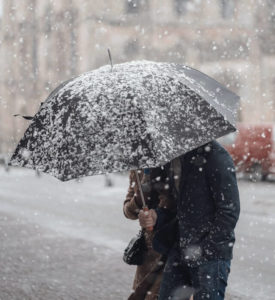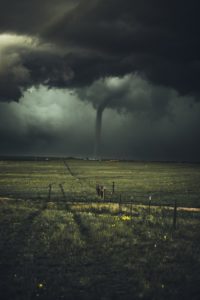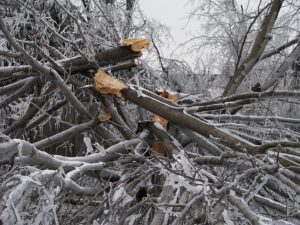Oklahoma City is known for its diverse and ever-changing weather patterns. From hot summers to mild winters, Oklahoma City residents experience a wide range of temperatures and precipitation throughout the year. The city is also prone to severe weather, including thunderstorms and tornadoes.
In this article, we’ll take a closer look at Oklahoma City’s weather patterns, including average temperatures, precipitation levels, and the frequency of severe weather events. We’ll also give you some practical tips for staying safe if you’re ever caught in Oklahoma’s extreme weather.
Whether you’re a resident or planning a visit, this article will give you a better understanding of what to expect from Oklahoma City’s weather.
Current OKC Forecast
What are the 4 seasons like in OKC?
Spring
Spring weather in Oklahoma City can be quite variable and unpredictable. The city experiences an average temperature range from the low 50s to the mid-70s in March, gradually warming up to the low 70s to mid-80s by May. The spring season is also known for its frequent thunderstorms, heavy rain and strong winds, as well as occasional tornadoes.
The city usually receives the majority of its annual precipitation during the spring months, with April being the wettest month. The city also experiences occasional hailstorms and flooding. Despite the occasional severe weather, spring can be a beautiful time of year in Oklahoma City with mild temperatures, blooming flowers, and new growth.
Summer
Summers in Oklahoma City are generally hot and humid, with average temperatures ranging from the mid-80s to the low 90s. The city typically experiences high humidity, which can make it feel even hotter. Thunderstorms are common during the summer months, particularly in the afternoons and evenings, providing some relief from the heat.
The city also sometimes experience heat waves, with temperatures rising above 100 degrees Fahrenheit. The sun is strong and UV index is high, so it’s important to stay hydrated and protect yourself from the sun. Overall, Oklahoma City’s summers are hot and humid, with occasional thunderstorms and heat waves.
Autumn
The weather in fall in Oklahoma City is generally mild with cool temperatures and lower humidity levels compared to summer. The city experiences an average temperature range from the mid-60s to the low 80s in September, gradually cooling down to the mid-50s to the low 70s by November.
The fall season brings beautiful foliage with trees changing color, making it a popular time for outdoor activities like hiking and biking. The city also experiences less rain than in the spring and summer, with an average of around 2.5 inches of precipitation per month. Fall is also a peak time for severe weather events such as thunderstorms and tornadoes, so it’s important to be aware of weather conditions and be prepared.
Winter
Winters in Oklahoma City are generally mild, with average temperatures ranging from the low 30s to the mid-50s. The city typically sees occasional snowfall, with average snowfall of around 9 inches per year, but it’s not uncommon for the city to have some years with no snowfall at all or just a dusting.
The occasional cold front can bring freezing temperatures and some ice, but usually they don’t last long. The city may also experience occasional freezing rain and sleet. Overall, Oklahoma City’s winters are relatively mild, with occasional cold snaps and snow or ice storms.
What are the hottest months in OKC?
The hottest months in Oklahoma City are generally June, July, and August. July is the hottest with an average high temperature of 92.9°, which is still cooler than the average for most places in Oklahoma. During the summer, the city also experiences high humidity levels, which can make it feel even hotter.
What are the coldest months in OKC?
The coldest months in Oklahoma City are generally December, January, and February, when temperatures can drop to the low 30s and high 20s Fahrenheit. During these months, the city also experiences occasional cold snaps with well-below freezing temperatures. The city is not known for prolonged cold spells, but it’s always good to have warm clothes in your wardrobe so you can be prepared for the occasion.
Precipitation
Rainfall
Oklahoma City receives an average of about 33 inches of precipitation per year. The majority of it falls during the spring and summer months, with May and June typically being the wettest months. The city also experiences occasional thunderstorms and heavy rain during these months, which can lead to flash flooding. The fall and winter months are generally drier, with an average of around 2-3 inches of precipitation per month.
Snowfall 
Oklahoma City typically sees an average of 6 – 8 inches of snowfall per year. Snowfall can occur during the winter months, typically between December and February, but it’s not uncommon for the city to have some years with no snowfall at all or just a dusting. The city is not known for prolonged snowfall or heavy accumulation, and it usually melts quickly, but it’s always good to be prepared and dress warmly.
How bad is the humidity in OKC?
The humidity in Oklahoma City can vary throughout the year, but it is generally higher during the summer months and lower during the winter months. In the summer, the city experiences high humidity levels, which can make it feel even hotter. The humidity can reach over 70% in June, July and August, making it feel oppressive and uncomfortable. In the winter, the humidity levels drop, averaging around 40-50%. This combined with the cool temperatures, makes it more comfortable to be outside. Overall, the humidity in Oklahoma City is not as high as in some other parts of the country, but during the summer months, it can definitely make the heat feel more intense.
Severe and Dangerous Weather
Oklahoma City is known for its severe weather, particularly during the spring and early summer months. The city is located in an area known as “Tornado Alley,” which is an area of the United States that is prone to frequent and severe thunderstorms, tornadoes, and other severe weather events. Thunderstorms are common in the area, particularly in the spring and early summer, and can bring heavy rain, strong winds, hail, and lightning.
In addition to tornadoes and thunderstorms, Oklahoma City is also at risk for other severe weather events such as flash floods and severe winds. These events can happen at any time of the year and can cause power outages and damage to buildings, so it’s important to stay informed and be prepared in case of severe weather.
Tornadoes
Oklahoma City is at a higher risk for tornadoes than most places in the country. These powerful storms can cause significant damage and destruction, and can be deadly.
 The highest risk of tornadoes in Oklahoma City is generally during the spring and early summer months. The peak of tornado season in Oklahoma City is generally between April and June, when the conditions are most favorable for the formation of tornadoes. However, you should keep in mind that tornadoes can technically occur any day of the year. It’s important to be aware of severe weather conditions and to have a plan in place in case of a tornado warning, regardless of the time of year.
The highest risk of tornadoes in Oklahoma City is generally during the spring and early summer months. The peak of tornado season in Oklahoma City is generally between April and June, when the conditions are most favorable for the formation of tornadoes. However, you should keep in mind that tornadoes can technically occur any day of the year. It’s important to be aware of severe weather conditions and to have a plan in place in case of a tornado warning, regardless of the time of year.
Central Oklahoma is one of the most tornado-prone places in the world, with about 150 tornadoes striking within Oklahoma City’s limits since 1890. For as long as we’ve been keeping weather records, Oklahoma City has been struck thirteen times by violent tornadoes, with 11 rated as EF4 and 2 rated as EF5. Even if you weren’t living here at the time, you may remember the deadly record breaking tornado of May 20th, 2013 that took the lives of 25 people and injured 377. (2013 Moore tornado)
In spite of the dangers of living in tornado alley, the good news is that some of the most experienced meteorologists live and work in the Oklahoma City metro, and Oklahoma has some of the best weather forecasting technology. In fact, the National Weather Center is located just over in Norman. (You can visit the National Weather Museum)
It can be quite scary sitting through a tornado warning, whether you’ve lived in Oklahoma your whole life, or you’re brand new to the area. However, in most cases, there’s a 10 to 15 minute warning before a tornado actually strikes, so it’s very likely you’ll have plenty of time to seek shelter.
If you find yourself in tornado weather, following these tips can help keep you and your family safe…
10 Tornado Safety Tips
1. Stay informed: Keep informed about the weather conditions and be aware of any tornado watches or warnings issued by local authorities.
2. Have a plan: Have a plan in place for what to do in case of a tornado. Know where the nearest shelter is and have a designated safe place in your home.
3. Seek shelter: When a tornado warning is issued, seek shelter immediately. The best place to take shelter is in a basement or storm cellar, or in an interior room on the lowest level of a building with no windows.
4. Stay away from windows: Windows can easily break during a tornado, so stay away from them and get as far away from them as possible.
5. Use protective cover: Use a blanket, mattress, or other thick item to cover yourself and protect yourself from flying debris.
6. Evacuate: If you are in a mobile home or other temporary structure, evacuate immediately if you can, and seek shelter in a more sturdy building.
7. Stay away from floodwaters: Stay away from floodwaters, as they can be contaminated and can hide dangerous debris or animals.
8. Keep listening: Keep listening to the radio or television for updates on the storm and for instructions from local authorities.
9. Be prepared: Keep emergency supplies such as a flashlight, battery-powered radio, first aid kit, and extra batteries on hand in case of power outages.
10. Stay Calm and stay safe. Follow the instructions of local authorities and take the necessary precautions to protect yourself and your loved ones.
Oklahoma Ice Storms
In recent years Oklahoma has been pounded with ice storms. Since 2007, ice storms were responsible for more than 55 deaths and power outages to more than 640,000 homes and businesses across the state. Infrastructure damage to cities, towns and counties alone exceeded $250 million.
In fact, it was only a couple of years ago that Oklahoma experienced a record breaking ice storm that left thousands without power.
Ice storms can make roads impossible to drive on; as well as damage power lines, trees, and buildings. Power outages are common during ice storms, as the heavy ice can cause power lines to snap or trees to fall. These power outages can be prolonged, and cause disruption to daily life.
If you find yourself in an Oklahoma ice storm, here are some safety tips to keep you and your loved ones safe and warm:
10 Ice Storm Safety Tips
1. Stay informed: Keep informed about the weather conditions and be aware of any ice storm warnings or watches issued by local authorities.
2. Stay indoors: Stay indoors during an ice storm if possible. Avoid unnecessary travel, as roads and sidewalks will be slick and dangerous.
3. Dress warmly: Dress warmly in layers to stay warm if you must go outside. Wear warm boots with good traction to help prevent slips and falls.
4. Be aware of black ice: Be aware of black ice, which can be difficult to see. It can form on bridges, overpasses and shaded areas.
5. Keep a winter emergency kit: Keep a winter emergency kit in your car that includes a blanket, flashlight, and extra warm clothes, as well as a small shovel, sand or cat litter, and a bag of salt or de-icer.
6. Keep emergency supplies at home: Keep emergency supplies at home such as a flashlight, battery-powered radio, extra blankets, and non-perishable food in case of power outages.
7. Check on neighbors: Check on elderly or vulnerable neighbors to make sure they are safe and warm.
8. Keep the heat on: Keep your heat on during a power outage to prevent pipes from freezing.
9. Bring your pets inside: During an ice storm, most pets don’t stand a chance against mother nature. If they can’t be inside, make sure they have adequate shelter and heat.
10. Be prepared to be without power: Be prepared to be without power for an extended period of time, and have a backup plan in place.
Frequently Asked Questions About OKC Weather
What is the average temperature in Oklahoma City?
The average temperature in Oklahoma City varies depending on the season. In the summer months (June to August), the average high temperature is around 90°F (32°C) and the average low temperature is around 70°F (21°C). In the winter months (December to February), the average high temperature is around 50°F (10°C) and the average low temperature is around 30°F (-1°C). Overall, the annual average temperature in Oklahoma City is around 61°F (16°C). However, it’s important to note that temperatures can vary widely from day to day and year to year.
Does Oklahoma City experience extreme weather conditions like tornadoes or hurricanes?
Yes, Oklahoma City experiences extreme weather conditions such as tornadoes, thunderstorms, and occasional ice storms. Oklahoma City is located in Tornado Alley, a region in the central United States that is particularly prone to tornadoes. While the city has not experienced a direct hit from a hurricane, it can be affected by the remnants of a hurricane passing through the region, bringing heavy rain and strong winds.
What is the typical humidity level in Oklahoma City?
The typical humidity level in Oklahoma City varies depending on the season. In the summer months, the humidity level is typically high, with an average relative humidity of around 70% to 80%. In the winter months, the humidity level is generally lower, with an average relative humidity of around 50% to 60%.
When is the rainy season in Oklahoma City?
Oklahoma City’s rainy season generally occurs in the late spring and early summer months, typically from May through June. During this time, the city experiences frequent thunderstorms, some of which can produce heavy rainfall and flash flooding.
Does it snow in Oklahoma City?
Yes, Oklahoma City does receive snowfall during the winter months. The city typically receives an average of around 8 to 9 inches (20 to 23 cm) of snow per year, with the heaviest snowfalls occurring in January and February.
What is the best time of year to visit Oklahoma City weather-wise?
The best time of year to visit Oklahoma City weather-wise is in the spring (April to May) or fall (September to October) when the temperatures are mild and the humidity is lower. During these seasons, the city experiences comfortable temperatures and fewer extreme weather events, making it an ideal time for outdoor activities and sightseeing.
How often does Oklahoma City experience severe weather alerts?
Oklahoma City experiences severe weather alerts fairly frequently, particularly during the spring and early summer months when thunderstorms and tornadoes are most common. The frequency of severe weather alerts can vary from year to year, but residents of Oklahoma City should be prepared for the possibility of severe weather and stay informed about weather conditions through local news sources and weather alerts.
How do I prepare for severe weather in Oklahoma City?
To prepare for severe weather in Oklahoma City, it is important to stay informed about weather conditions by monitoring local news sources and weather alerts. Make sure to have a plan in place in case of a tornado warning, including identifying a safe shelter area and knowing the fastest route to get there. It’s also a good idea to stock up on emergency supplies, such as a first aid kit, bottled water, and non-perishable food items, in case of power outages or other disruptions. (Learn more about preparing for a tornado here.)
What are the typical wind speeds in Oklahoma City?
The average wind speed in the city is around 12 miles per hour (19 km/h), with occasional gusts reaching up to 50 miles per hour (80 km/h) during severe weather events.
Is Oklahoma City prone to flooding?
Yes, Oklahoma City is prone to flooding, particularly during the rainy season and in low-lying areas of the city. The city has experienced several significant floods in the past, including the devastating floods of 1923 and 1976.
What is the UV index like in Oklahoma City?
The UV index in Oklahoma City varies depending on the season, but can be quite high in the summer months, with an average index rating of around 9 or 10 (very high to extreme).
How do Oklahoma City’s weather patterns compare to other cities in the US?
Oklahoma City’s weather patterns are influenced by its location in the Great Plains region, which is known for its extreme weather events like tornadoes and thunderstorms. Compared to other cities in the US, Oklahoma City tends to have higher average wind speeds and humidity levels, and experiences more severe weather alerts than many other cities.
What should I wear in Oklahoma City during the summer?
In the summer months in Oklahoma City, it is recommended to wear light and breathable clothing, such as cotton t-shirts, shorts, and sandals, as temperatures can be quite hot and humid.
What should I wear in Oklahoma City during the winter?
In the winter months, you should typically wear warm clothing, such as a coat, gloves, and a hat, as temperatures can be quite cold, especially at night. However, keep in mind that temperatures can vary greatly, even from day to day; so it is recommended to dress in layers so you can remove them as needed.
In conclusion…
Oklahoma City is known for its diverse and ever-changing weather patterns. From hot summers to mild winters, residents experience a wide range of temperatures and precipitation throughout the year.
The city is also prone to severe weather, including thunderstorms, tornadoes, flash floods and ice storms, particularly during the spring and early summer months. It’s important for residents and visitors to stay informed and be prepared for all types of weather, by having a plan in place, being aware of severe weather conditions, and keeping emergency supplies on hand.
Despite the occasional severe weather, Oklahoma City offers a comfortable climate, beautiful seasons and a lot of outdoor activities to enjoy. Overall, Oklahoma City’s weather is a unique aspect of the city, and it’s something that residents and visitors should be aware of and prepared for.





























